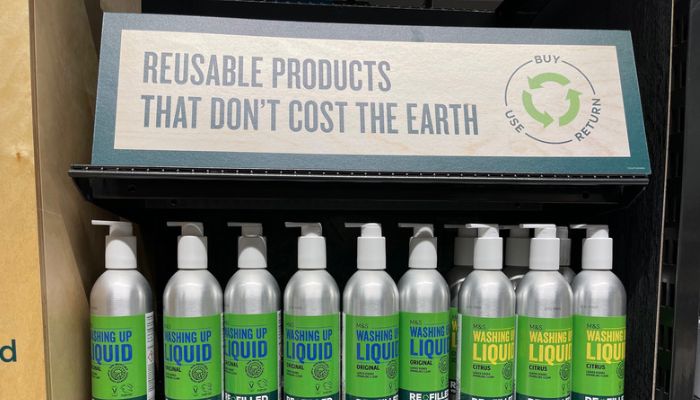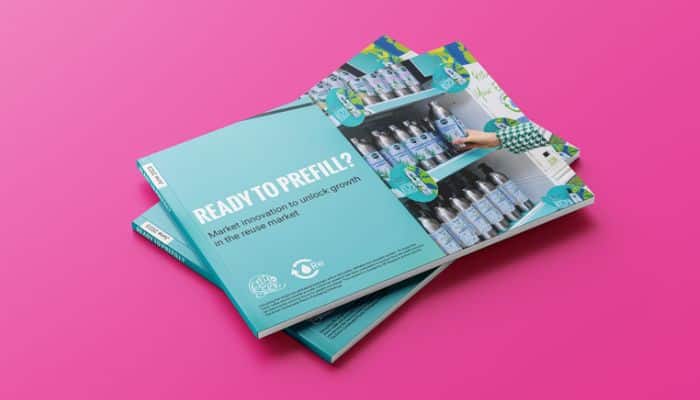The future is Prefill
Why prefilled returnable packaging could be the answer to brands’ & retailers’ prayers.
A NEW report, released today by City to Sea and Re to mark World Refill Day, reveals that the key to consumers choosing reuse over single-use in UK supermarkets could be packaging innovation.
The report, titled ‘Ready to prefill? Market innovation to unlock growth in the market’, provides, for the first time, insight into current consumer perceptions, barriers and motivations relating to prefilled returnable packaging. It also outlines recommendations for brands and retailers to help them meet waste reduction targets and save money ahead of the introduction of Extended Producer Responsibility and the associated costs this carries.
Bringing together insights from behaviour-change consultants and the organisation behind the Refill campaign, City to Sea, supply chain specialists Re (by Beauty Kitchen), and some of the biggest retail and grocery brands in the UK, together with findings from a first-of-its-kind, nationally representative consumer research project, this new report has been part funded by UK Research and Innovation’s (UKRI) Smart Sustainable Plastic Packaging initiative, which helps consumers transition to reuse, and brands and retailers meet packaging reduction targets.

Report findings revealed there is high consumer demand for prefill reuse packaging when available in the right location, at the right price and when the barriers to adoption are removed. Lack of consumer demand and readiness is often cited as the reason for low investment in circular systems at scale. However, the new research revealed:
- Consumers demand is high. Intention to buy is there – 69% of respondents indicated they are likely or very likely to try products in returnable packaging if they are available where they shop, but lack of availability is preventing trial.
- Prefilled returnable packaging presents a significant opportunity for brands. Over half of respondents (53%) said they were more likely to buy from a brand that offered products in prefilled returnable packaging, rising to 84% among those that had previously bought products in returnable packaging.
- Consumers are unwilling to compromise on price. Six in 10 indicated that value for money was the most important criteria influencing their product choice.
- However, almost half of respondents are prepared to pay a deposit for a product that they buy in returnable packaging.

GROWTH IN THE REUSE MARKET
Prefilled returnable packaging present a promising new alternative to the current ‘self-refill’ or ‘refill-in-store’ model, which has so far been met with limited success for retailers. Investing in prefills could potentially be a complete game-changer when it comes to reducing plastic packaging for retailers – a key target of The UK Plastics Pact, a cross-industry initiative to reduce plastic waste.
The reuse market, while growing, remains small. And so far, efforts have largely focused on recycling and reducing single-use packaging, rather than on rethinking how to keep packaging circulating in the system. Pilots have been unambitious and uptake limited, despite evidence of growing consumer demand and significant investment from retailers, brands and other stakeholders. Four in ten businesses that have signed up to the global commitment have reuse pilots in place, and an additional 56% have pilots planned between now and 2025. However, refillable and returnable products still only accounted for 1.2% of the UK market in 2022. Most pilots are based on refill-in-store models, where the consumer brings their own container to be refilled with a desired product (e.g. at an in-store dispenser), uses the product, cleans the container themselves ready to be used again
Most investment by brands and retailers to date has been in reducing packaging or making it more recyclable. Trials to date on reuse and refill have been limited and isolated, lacking collaboration and a longer-term vision. This report provides further evidence of a frustrated consumer demand and the need for stakeholder collaboration to accelerate the transition to reuse.
Ongoing concerns about the commercial viability of reuse mean few brands have set meaningful targets or timescales to roll pilots out more widely. This will only be solved through innovation, cross-industry collaboration and increased efficiency to unlock economies of scale. Re has set out to address these issues with a vision for a cross category, professionally refillable, reusable packaging platform that is consumer centric and centres around smart standardised returnable packaging-as-a-service to reduce the cost and risk barriers for stakeholders.
World Refill Day is an important part of building momentum for the transition to reusable packaging which, for many applications, could move UK retail towards a more sustainable future. SSPP has committed several million pounds in funding to that end, supporting two large-scale projects focused on introducing innovative reusable packaging models in UK retail.

ENGAGING THE CONSUMER
Findings from the research reveal that, unsurprisingly during a cost-of-living crisis, consumers are unwilling to compromise on price. However, willingness is there and customers are keen to adopt reuse systems to reduce waste, limit use of single-use plastics and decrease their carbon footprint.
Prefill returnable packaging presents an appealing alternative for consumers because the experience of purchasing these products is closer to the traditional shopping experience and feels more familiar. Crucially, supplying products in prefilled returnable packaging mitigates many of the issues and blockers to adoption that consumers have with refill-in-store models, relating to ease, convenience and hygiene concerns.
This is promising, however, before we can encourage consumers to embrace prefilled returnable packaging, we need to know more about them. The research revealed five key consumer groups and how likely each of them is to use prefills, providing a deeper understanding of their needs and motivations, which will help determine how to target them.
This is a revolutionary approach, by collaborating on a full-system solution brands and retailers can effectively scale-up an effective reuse model that avoids the consumer barriers. It is clear to everyone that consumers want to shop more sustainably, our climate desperately needs us to but, to date the missing link has been the innovative solution – the future is prefill.

Download the Report
The research outlines clear recommendations for how retailers and brands can drive first time trial and boost packaging return rates for prefilled systems. Making the user experience as convenient and frictionless as possible will be fundamental to getting consumers to try the product for the first time and to converting them into repeat purchasers. This that instead of separating prerefilled products into separate areas or aisles which only serve to limit the experience to the most dedicated shoppers, products must be made available in the same location as the single-use alternatives. Return processes also need to be seamlessly integrated into the existing retail experience to ensure a smooth and positive consumer experience from start to finish.
This new report paves the way for market innovation and promises to prove instrumental in helping to replace single-use products on retail shelves and making prefill reuse packaging the modus operandi for the future.
The insights from the research will be launched TODAY as part of the Global Reuse Summit as part of the retail innovation section. You can register for the completely free event here. The launch of the report is happening during the summit and will be presented by City to Sea’s Head of Campaigns, Jo Morley and Behaviour Change Expert, Livvy Drake.
You can also download the full report on the website here.

